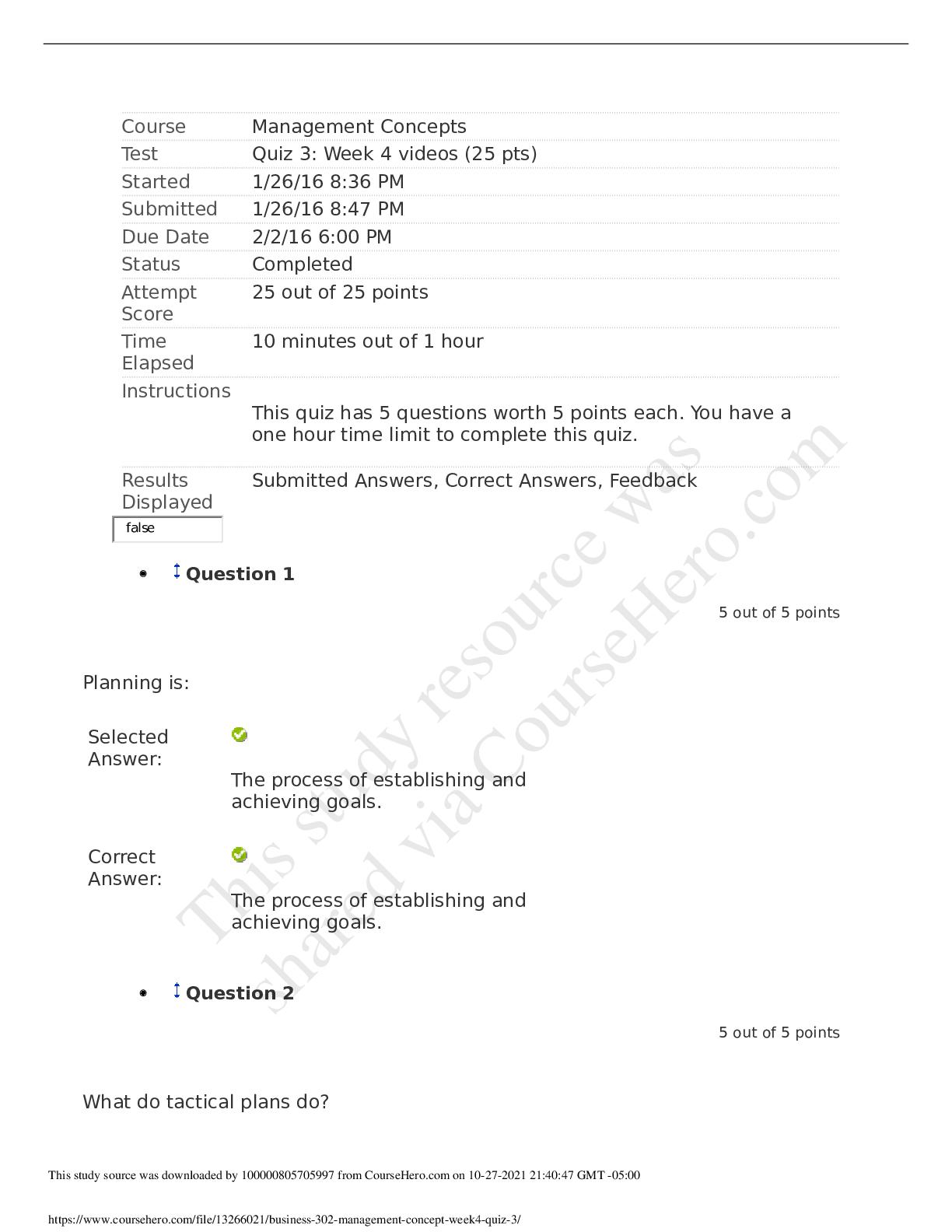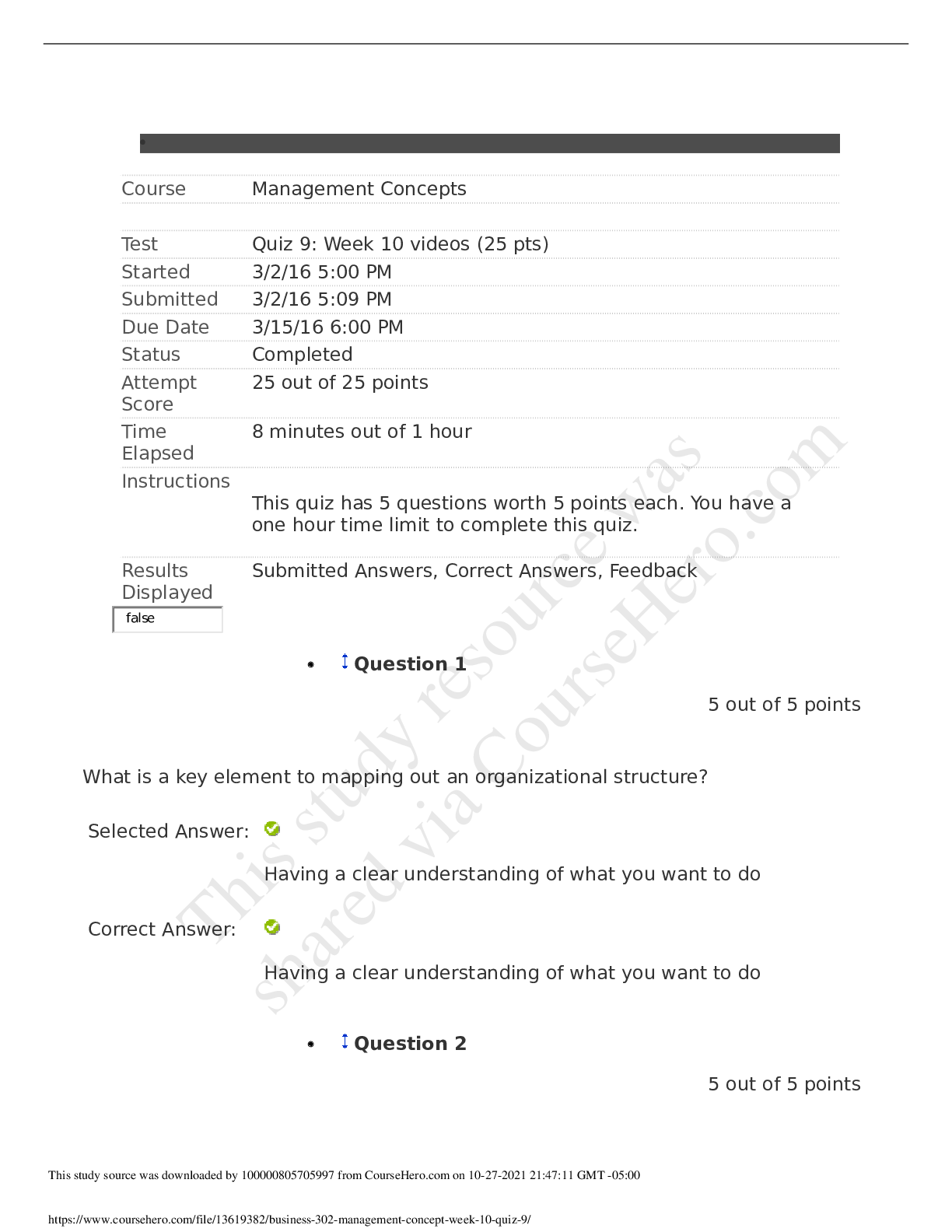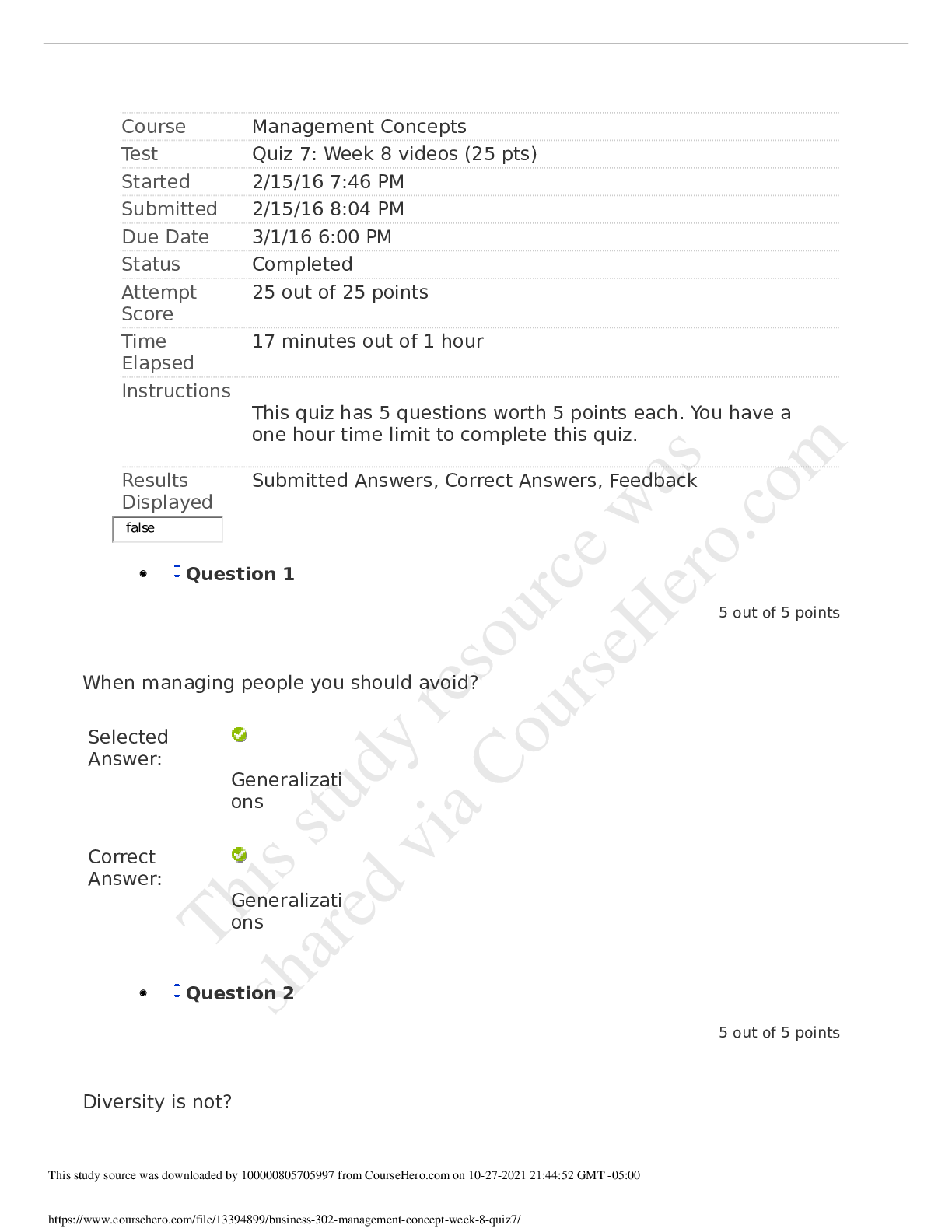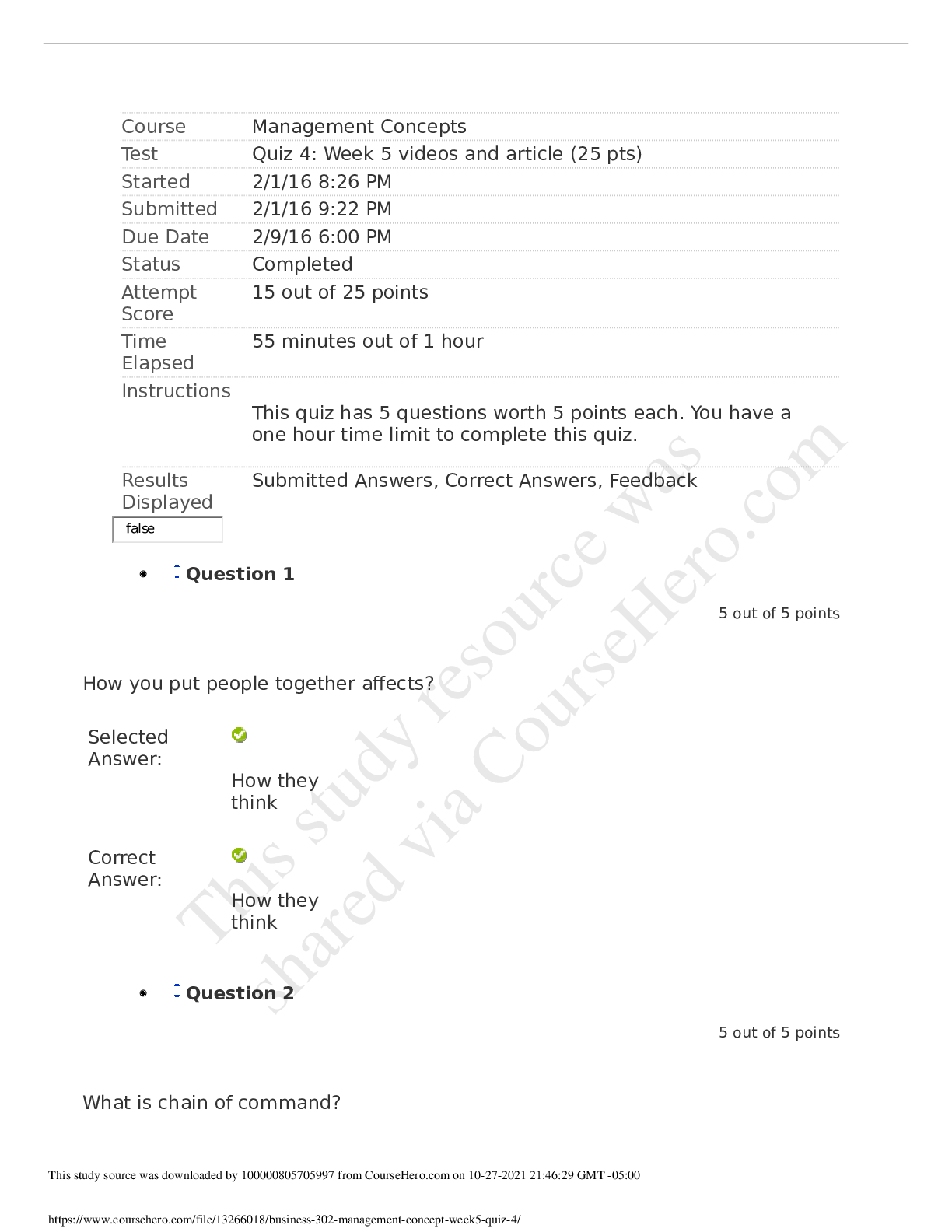Education > QUESTIONS & ANSWERS > Test Bank CHAPTER 22 ACCOUNTING CHANGES AND ERROR ANALYSIS (All)
Test Bank CHAPTER 22 ACCOUNTING CHANGES AND ERROR ANALYSIS
Document Content and Description Below
Test Bank CHAPTER 22 ACCOUNTING CHANGES AND ERROR ANALYSIS CHAPTER 22 ACCOUNTING CHANGES AND ERROR ANALYSIS TRUE-FALSe—Conceptual Answer No. Description F... 1. Change in accounting estimate. T 2. Errors in financial statements. F 3. Adoption of a new principle. T 4. Retrospective application of accounting principle. F 5. Reporting cumulative effect of change in principle. T 6. Disclosure requirements for a change in principle. T 7. Indirect effect of an accounting change. T 8. Retrospective application impracticality. F 9. Reporting changes in accounting estimates. T 10. Change in principle vs. change in estimate. F 11. Accounting for change in depreciation method. F 12. Accounting for change in reporting entities. T 13. Example of a change in reporting entities. F 14. Accounting error vs. change in estimate. T 15. Accounting for corrections of errors. T 16. New principle created by FASB standard. F 17. Balance sheet errors. F 18. Definition of counterbalancing errors. T 19. Accounting for counterbalancing errors. T 20. Correcting entries for noncounterbalancing errors. Multiple Choice—Conceptual Answer No. Description b 21. Accounting changes and consistency concept. b 22. Identify changes in accounting principle. c 23. Identify a non-retrospective change. d 24. Identify a change in accounting principle. a 25. Entry to record a change in depreciation methods. c 26. Disclosures required for a change in depreciation methods. c 27. Change from percentage-of-completion to completed-contracts. d 28. Disclosures required for a change from LIFO to FIFO. b 29. Change from FIFO to LIFO. c 30. Change in accounting estimate. a 31. Change in accounting estimate. b 32. Identify a change in accounting estimate. b 33. Change in accounting estimate. c 34. Identify a change in accounting estimate. d 35. Identify a change in reporting entity. c 36. Retroactive reporting a change in reporting entity. c 37. Identify a correction of an error. b 38. Identification of counterbalancing errors. Multiple Choice—Conceptual (cont.) Answer No. Description c 39. Impact of failure to record purchase and count ending inventory. c 40. Impact of failure to record purchase and count ending inventory. Multiple Choice—Computational Answer No. Description b 41. Calculate cumulative effect of a change in depreciation method. b 42. Calculate cumulative effect of a change in depreciation method. c 43. Calculate net income with change in accounting principle with tax effects. d 44. Calculate cumulative effect of accounting change. c 45. Calculate depreciation expense after change in accounting principle. d 46. Calculate cumulative effect of a change on retained earnings. b 47. Calculate cumulative effect of a change on retained earnings. c 48. Compute depreciation expense after a change in depreciation methods. b 49. Calculate cumulative effect of a change in inventory methods. c 50. Calculate net income after a change to LIFO method. a 51. Calculate net income with change from FIFO to LIFO. b 52. Calculate depreciation after a change in estimate. a 53. Calculate net income with change in an accounting estimate. a 54. Determine depreciation expense after a change in estimated life. a 55. Compute effect of errors on income before taxes. c 56. Compute effect of errors on retained earnings. d 57. Calculate effect of errors on net income. c 58. Calculate effect of errors on working capital. c 59. Calculate effect of errors on retained earnings. a 60. Effect of errors on income and retained earnings. a 61. Calculate effect of errors on net income. b 62. Calculate effect of errors on retained earnings. c 63. Calculate effect of errors on working capital. d 64. Determine cumulative effect of error on income statement. c 65. Determine the understatement of retained earnings. a 66. Calculate effect of error on net income. c 67. Compute effect of error on retained earnings. Multiple Choice—CPA Adapted Answer No. Description b 68. Identify a change in accounting principle. c 69. Cumulative effect of a change from weighted-average to LIFO. a 70. Reporting a change to FIFO from LIFO. a 71. Balance of accumulated depreciation after a change in estimate. b 72. Determine carrying value of a patent with a change in estimate. d 73. Reporting royalty income when amount realized differs from estimate. b 74. Depreciation expense to be recorded following an error. c 75. Impact of failure to accrue insurance costs. a 76. Retained earnings balance with multiple errors. Exercises Item Description E22-77 Matching accounting changes to situations. E22-78 How changes or corrections are recognized. E22-79 Matching disclosures to situations. E22-80 Change in accounting principle. E22-81 Change in estimate, change in entity, corrections of errors. E22-82 Changes in depreciation methods, estimates. E22-83 Noncounterbalancing error. E22-84 Effects of errors. E22-85 Effects of errors. PROBLEMS Item Description P22-86 Accounting for changes and error corrections. P22-87 Corrections of errors. P22-88 Error corrections and adjustments. CHAPTER LEARNING OBJECTIVES 1. Identify the types of accounting changes. 2. Describe the accounting for changes in accounting principles. 3. Understand how to account for retrospective accounting changes. 4. Understand how to account for impracticable changes. 5. Describe the accounting for changes in estimates. 6. Identify changes in a reporting entity. 7. Describe the accounting for correction of errors. 8. Identify economic motives for changing accounting methods. 9. Analyze the effect of errors. SUMMARY OF LEARNING OBJECTIVES BY QUESTIONS Item Type Item Type Item Type Item Type Item Type Item Type Item Type Learning Objective 1 1. TF 2. TF 21. MC Learning Objective 2 3. TF 22. MC 24. MC 68. MC 78. E 4. TF 23. MC 25. MC 77. E Learning Objective 3 5. TF 26. MC 43. MC 46. MC 49. MC 79. E 6. TF 41. MC 44. MC 47. MC 69. MC 80. E 7. TF 42. MC 45. MC 48. MC 78. E 86. P Learning Objective 4 8. TF 28. MC 50. MC 70. MC 79. E 86. P 27. MC 29. MC 51. MC 78. E 80. E Learning Objective 5 9. TF 30. MC 33. MC 53. MC 72. MC 78. E 82. E 10. TF 31. MC 34. MC 54. MC 73. MC 79. E 86. P 11. TF 32. MC 52. MC 71. MC 77. E 81. E 88. P Learning Objective 6 12. TF 13. TF 35. MC 36. MC 77. E 78. E 81. E Learning Objective 7 14. TF 37. MC 74. MC 79. E 86. P 15. TF 55. MC 77. E 81. E 87. P 16. TF 56. MC 78. E 83. E 88. P Learning Objective 9 17. TF 38. MC 58. MC 62. MC 66. MC 84. E 18. TF 39. MC 59. MC 63. MC 67. MC 85. E 19. TF 40. MC 60. MC 64. MC 75. MC 86. P 20. TF 57. MC 61. MC 65. MC 76. MC 87. P Note: TF = True-False MC = Multiple Choice E = Exercise P = Problem TRUE-FALSE—Conceptual 1. A change in accounting principle is a change that occurs as the result of new information or additional experience. 2. Errors in financial statements result from mathematical mistakes or oversight or misuse of facts that existed when preparing the financial statements. 3. Adoption of a new principle in recognition of events that have occurred for the first time or that were previously immaterial is treated as an accounting change. 4. Retrospective application refers to the application of a different accounting principle to recast previously issued financial statements—as if the new principle had always been used. 5. When a company changes an accounting principle, it should report the change by reporting the cumulative effect of the change in the current year’s income statement. 6. One of the disclosure requirements for a change in accounting principle is to show the cumulative effect of the change on retained earnings as of the beginning of the earliest period presented. 7. An indirect effect of an accounting change is any change to current or future cash flows of a company that result from making a change in accounting principle that is applied retrospectively. 8. Retrospective application is considered impracticable if a company cannot determine the prior period effects using every reasonable effort to do so. 9. Companies report changes in accounting estimates retrospectively. 10. When it is impossible to determine whether a change in principle or change in estimate has occurred, the change is considered a change in estimate. 11. Companies account for a change in depreciation methods as a change in accounting principle. 12. When companies make changes that result in different reporting entities, the change is reported prospectively. 13. Changing the cost or equity method of accounting for investments is an example of a change in reporting entity. 14. Accounting errors include changes in estimates that occur because a company acquires more experience, or as it obtains additional information. 15. Companies record corrections of errors from prior periods as an adjustment to the beginning balance of retained earnings in the current period. 16. If an FASB standard creates a new principle, expresses preference for, or rejects a specific accounting principle, the change is considered clearly acceptable. 17. Balance sheet errors affect only the presentation of an asset or liability account. 18. Counterbalancing errors are those that will be offset and that take longer than two periods to correct themselves. 19. For counterbalancing errors, restatement of comparative financial statements is necessary even if a correcting entry is not required. 20. Companies must make correcting entries for noncounterbalancing errors, even if they have closed the prior year’s books. True-False Answers—Conceptual Item Ans. Item Ans. Item Ans. Item Ans. 1. F 6. T 11. F 16. T 2. T 7. T 12. F 17. F 3. F 8. T 13. T 18. F 4. T 9. F 14. F 19. T 5. F 10. T 15. T 20. T MULTIPLE CHOICE—Conceptual 21. Accounting changes are often made and the monetary impact is reflected in the financial statements of a company even though, in theory, this may be a violation of the accounting concept of a. materiality. b. consistency. c. conservatism. d. objectivity. 22. Which of the following is not treated as a change in accounting principle? a. A change from LIFO to FIFO for inventory valuation b. A change to a different method of depreciation for plant assets c. A change from full-cost to successful efforts in the extractive industry d. A change from completed-contract to percentage-of-completion 23. Which of the following is not a retrospective-type accounting change? a. Completed-contract method to the percentage-of-completion method for long-term contracts b. LIFO method to the FIFO method for inventory valuation c. Sum-of-the-years'-digits method to the straight-line method d. "Full cost" method to another method in the extractive industry 24. Which of the following is accounted for as a change in accounting principle? a. A change in the estimated useful life of plant assets. b. A change from the cash basis of accounting to the accrual basis of accounting. c. A change from expensing immaterial expenditures to deferring and amortizing them as they become material. d. A change in inventory valuation from average cost to FIFO. 25. A company changes from straight-line to an accelerated method of calculating depreciation, which will be similar to the method used for tax purposes. The entry to record this change should include a a. credit to Accumulated Depreciation. b. debit to Retained Earnings in the amount of the difference on prior years. c. debit to Deferred Tax Asset. d. credit to Deferred Tax Liability. 26. Which of the following disclosures is required for a change from sum-of-the-years-digits to straight-line? a. The cumulative effect on prior years, net of tax, in the current retained earnings statement b. Restatement of prior years’ income statements c. Recomputation of current and future years’ depreciation d. All of these are required. 27. A company changes from percentage-of-completion to completed-contract, which is the method used for tax purposes. The entry to record this change should include a a. debit to Construction in Process. b. debit to Loss on Long-term Contracts in the amount of the difference on prior years, net of tax. c. debit to Retained Earnings in the amount of the difference on prior years, net of tax. d. credit to Deferred Tax Liability. 28. Which of the following disclosures is required for a change from LIFO to FIFO? a. The cumulative effect on prior years, net of tax, in the current retained earnings statement b. The justification for the change c. Restated prior year income statements d. All of these are required. 29. Stone Company changed its method of pricing inventories from FIFO to LIFO. What type of accounting change does this represent? a. A change in accounting estimate for which the financial statements for prior periods included for comparative purposes should be presented as previously reported. b. A change in accounting principle for which the financial statements for prior periods included for comparative purposes should be presented as previously reported. c. A change in accounting estimate for which the financial statements for prior periods included for comparative purposes should be restated. d. A change in accounting principle for which the financial statements for prior periods included for comparative purposes should be restated. 30. Which type of accounting change should always be accounted for in current and future periods? a. Change in accounting principle b. Change in reporting entity c. Change in accounting estimate d. Correction of an error 31. Which of the following is (are) the proper time period(s) to record the effects of a change in accounting estimate? a. Current period and prospectively b. Current period and retrospectively c. Retrospectively only d. Current period only 32. When a company decides to switch from the double-declining balance method to the straight-line method, this change should be handled as a a. change in accounting principle. b. change in accounting estimate. c. prior period adjustment. d. correction of an error. 33. The estimated life of a building that has been depreciated 30 years of an originally estimated life of 50 years has been revised to a remaining life of 10 years. Based on this information, the accountant should a. continue to depreciate the building over the original 50-year life. b. depreciate the remaining book value over the remaining life of the asset. c. adjust accumulated depreciation to its appropriate balance, through net income, based on a 40-year life, and then depreciate the adjusted book value as though the estimated life had always been 40 years. d. adjust accumulated depreciation to its appropriate balance through retained earnings, based on a 40-year life, and then depreciate the adjusted book value as though the estimated life had always been 40 years. 34. Which of the following statements is correct? a. Changes in accounting principle are always handled in the current or prospective period. b. Prior statements should be restated for changes in accounting estimates. c. A change from expensing certain costs to capitalizing these costs due to a change in the period benefited, should be handled as a change in accounting estimate. d. Correction of an error related to a prior period should be considered as an adjustment to current year net income. 35. Which of the following describes a change in reporting entity? a. A company acquires a subsidiary that is to be accounted for as a purchase. b. A manufacturing company expands its market from regional to nationwide. c. A company divests itself of a European branch sales office. d. Changing the companies included in combined financial statements. 36. Presenting consolidated financial statements this year when statements of individual companies were presented last year is a. a correction of an error. b. an accounting change that should be reported prospectively. c. an accounting change that should be reported by restating the financial statements of all prior periods presented. d. not an accounting change. 37. An example of a correction of an error in previously issued financial statements is a change a. from the FIFO method of inventory valuation to the LIFO method. b. in the service life of plant assets, based on changes in the economic environment. c. from the cash basis of accounting to the accrual basis of accounting. d. in the tax assessment related to a prior period. 38. Counterbalancing errors do not include a. errors that correct themselves in two years. b. errors that correct themselves in three years. c. an understatement of purchases. d. an overstatement of unearned revenue. 39. A company using a perpetual inventory system neglected to record a purchase of merchandise on account at year end. This merchandise was omitted from the year-end physical count. How will these errors affect assets, liabilities, and stockholders' equity at year end and net income for the year? Assets Liabilities Stockholders' Equity Net Income a. No effect Understate Overstate Overstate. b. No effect Overstate Understate Understate. c. Understate Understate No effect No effect. d. Understate No effect Understate Understate. 40. If, at the end of a period, a company erroneously excluded some goods from its ending inventory and also erroneously did not record the purchase of these goods in its accounting records, these errors would cause a. the ending inventory and retained earnings to be understated. b. the ending inventory, cost of goods sold, and retained earnings to be understated. c. no effect on net income, working capital, and retained earnings. d. cost of goods sold and net income to be understated. Multiple Choice Answers—Conceptual Item Ans. Item Ans. Item Ans. Item Ans. Item Ans. Item Ans. Item Ans. 21. b 24. d 27. c 30. c 33. b 36. c 39. c 22. b 25. a 28. d 31. a 34. c 37. c 40. c 23. c 26. c 29. b 32. b 35. d 38. b Multiple Choice—Computational 41. On January 1, 2010, Neal Corporation acquired equipment at a cost of $900,000. Neal adopted the sum-of-the-years’-digits method of depreciation for this equipment and had been recording depreciation over an estimated life of eight years, with no residual value. At the beginning of 2013, a decision was made to change to the straight-line method of depreciation for this equipment. The depreciation expense for 2013 would be a. $46,875. b. $75,000. c. $112,500. d. $180,000. 42. On January 1, 2010, Knapp Corporation acquired machinery at a cost of $500,000. Knapp adopted the double-declining balance method of depreciation for this machinery and had been recording depreciation over an estimated useful life of ten years, with no residual value. At the beginning of 2013, a decision was made to change to the straight-line method of depreciation for the machinery. The depreciation expense for 2013 would be a. $25,600. b. $36,572. c. $50,000. d. $71,428. 43. On January 1, 2010, Piper Co., purchased a machine (its only depreciable asset) for $450,000. The machine has a five-year life, and no salvage value. Sum-of-the-years'-digits depreciation has been used for financial statement reporting and the elective straight-line method for income tax reporting. Effective January 1, 2013, for financial statement reporting, Piper decided to change to the straight-line method for depreciation of the machine. Assume that Piper can justify the change. Piper's income before depreciation, before income taxes, and before the cumulative effect of the accounting change (if any), for the year ended December 31, 2013, is $375,000. The income tax rate for 2013, as well as for the years 2010-2012, is 30%. What amount should Piper report as net income for the year ended December 31, 2013? a. $90,000 b. $136,500 c. $231,000 d. $262,500 Use the following information for questions 44 and 45. Ventura Corporation purchased machinery on January 1, 2012 for $840,000. The company used the sum-of-the-years’-digits method and no salvage value to depreciate the asset for the first two years of its estimated six-year life. In 2013, Ventura changed to the straight-line depreciation method for this asset. The following facts pertain: 2012 2013 Straight-line $140,000 $140,000 Sum-of-the-years’-digits 240,000 200,000 44. Ventura is subject to a 40% tax rate. The cumulative effect of this accounting change on beginning retained earnings is a. $180,000. b. $160,000. c. $96,000. d. $0. 45. The amount that Ventura should report for depreciation expense on its 2014 income statement is a. $160,000. b. $140,000. c. $100,000. d. none of the above. 46. During 2013, a construction company changed from the completed-contract method to the percentage-of-completion method for accounting purposes but not for tax purposes. Gross profit figures under both methods for the past three years appear below: Completed-Contract Percentage-of-Completion 2011 $ 475,000 $ 700,000 2012 625,000 950,000 2013 700,000 1,050,000 $1,800,000 $2,700,000 Assuming an income tax rate of 40% for all years, the affect of this accounting change on prior periods should be reported by a credit of a. $540,000 on the 2013 income statement. b. $330,000 on the 2013 income statement. c. $540,000 on the 2013 retained earnings statement. d. $330,000 on the 2013 retained earnings statement. Use the following information for questions 47 and 48. On January 1, 2010, Nobel Corporation acquired machinery at a cost of $800,000. Nobel adopted the straight-line method of depreciation for this machine and had been recording depreciation over an estimated life of ten years, with no residual value. At the beginning of 2013, a decision was made to change to the double-declining balance method of depreciation for this machine. 47. Assuming a 30% tax rate, the cumulative effect of this accounting change on beginning retained earnings, is a. $89,600. b. $0. c. $105,280. d. $150,400. 48. The amount that Nobel should record as depreciation expense for 2013 is a. $80,000. b. $112,000. c. $160,000. d. none of the above. 49. On December 31, 2013 Dean Company changed its method of accounting for inventory from weighted average cost method to the FIFO method. This change caused the 2013 beginning inventory to increase by $630,000. The cumulative effect of this accounting change to be reported for the year ended 12/31/13, assuming a [Show More]
Last updated: 1 year ago
Preview 1 out of 27 pages

Buy this document to get the full access instantly
Instant Download Access after purchase
Add to cartInstant download
We Accept:

Reviews( 0 )
$12.00
Document information
Connected school, study & course
About the document
Uploaded On
Nov 03, 2020
Number of pages
27
Written in
Additional information
This document has been written for:
Uploaded
Nov 03, 2020
Downloads
0
Views
71










.png)

